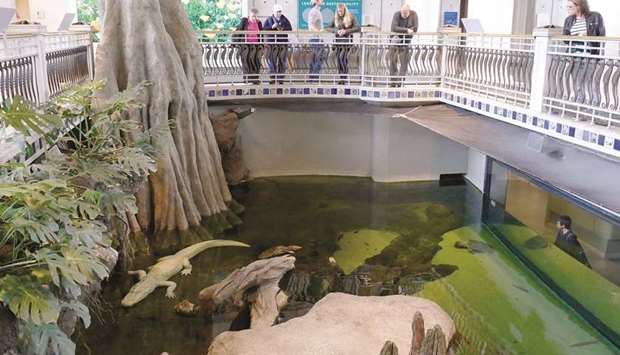Claude, a snow-white albino crocodile, is one of the main attractions at the California Academy of Sciences. He was 13 years old when the academy moved into a new building designed by star Italian architect Renzo Piano in 2008.
The building, which contains an aquarium, a planetarium, a natural history museum and research and educational facilities, has a green roof - in more than just the literal sense - and numerous sustainable features.
The old building, which dated back to 1916, was badly damaged in an earthquake in 1989 and was later torn down. On the same site, Piano has created a two-floor spectacle flooded with natural light, with incredible views - not only of the surrounding Golden Gate Park, but also through round windows on the roof as well as down into an aquarium below. The nearly 500-million-dollar construction, made from glass and recycled steel girders, immediately received a Leadership in Energy and Environmental Design (LEED) Platinum award in the category ‘Design and Construction.’
Then, in 2011, it also received a LEED Platinum award in the ‘Existing Buildings: Operations and Maintenance’ category, which confirms that its day-to-day operations and business practices also meet the highest standards of sustainability. The museum was the first in the world to receive this ‘double platinum’ rating, something it believes makes it the greenest museum in the world.
Then, in 2017, it announced that it would be the first major museum to bring net emissions of greenhouse gases to zero by 2025, in line with the Paris Agreement on climate change. One feature of the museum that is both environmentally friendly and a major draw for visitors is its ‘living roof,’ covered with 10,000 square metres of plants and other vegetation.
“On the rooftop we find native butterflies, red-tailed hawks and other birds using the space,” says Scott Moran, senior director of exhibits and architecture at the museum. The roof also absorbs water, so that it doesn’t have to go through the sewage system. Ten years after it was first built, only a few tweaks have been necessary to optimise its function, Moran says.
For example, the tops of the roof’s green mounds of earth are now reserved for plants that are resistant to dry conditions, as they are more exposed to the wind. Things beneath the roof have changed more dramatically, especially in the planetarium and the tropical rainforest.
“In recent years, we have focused a lot more on incorporating sustainability in all of the exhibits,” Moran says. “We explain to the public what the challenges to our ecosystems are, and that we as a species need to think more globally and work together to protect them.”
Beneath the glass dome of the rainforest, the air hot and humid, Moran makes his way up the spiral staircase that leads from the swampy roots below up to the tropical treetops. Birds and butterflies flutter around the heads of visitors. “Eat less meat,” a sign advises them. Rainforests are being destroyed to make way for livestock farming, they are informed, and cultivating meat for human consumption puts a huge strain on the planet.
A glass elevator leads to the next stop, the underwater world beneath the museum’s belly. Sting rays and small sharks swim above the heads of curious visitors. The light from the rainforest above shimmers through glass.
The museum’s four-metre-deep coral reef, filled with glowing fish, is one of the largest indoor reefs in the world. As well as providing a colourful attraction, it’s also being used for research into how threatened reefs can be protected from climate change. The aquarium is growing artificial corals, which are then transferred to the sea to see how they fare in the wild.
Michelle Trautwein, the museum’s spiders and insects specialist, is one of 15 curators at the museum, which employs 600 staff. She and the other scientists share the office space in the basement with 46 million exhibits, from tiny tropical beetles to stuffed grizzly bears.
Now and then, Trautwein comes out of her office and mingles with the visitors, asking for small skin samples. She’s studying mites that make a home for themselves on our faces and other body parts. The tiny spider-like creatures can be found on the skin of almost every human, she says.
The 42-year-old biologist also researches the role of beetles and other bugs in human homes. “I want to let people know that we are not alone here, we are not isolated in these sterile houses,” she says. “There are arthropods on our bodies and all over our houses. We are part of this living ecosystem. To maintain the health of these ecosystems beyond our own species is really critical.”– DPA

